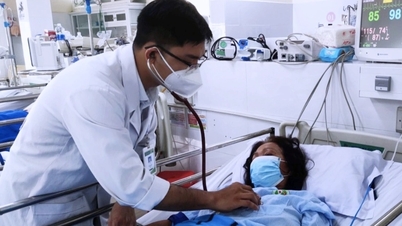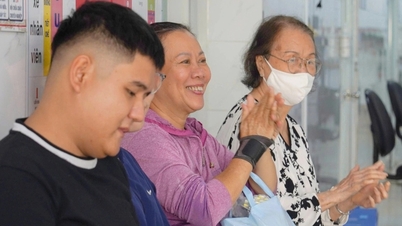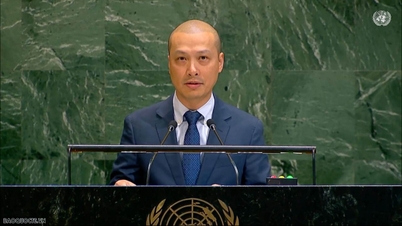As the population ages and people's awareness of health increases, the demand for health care is also increasing, and spending on this area is also greater, putting significant pressure on China's health security system.
 |
| Chinese people are investing more in their health and living longer, leading to rising medical costs. Illustrative photo. (Source: SCMP) |
In just two weeks, to pay for chronic cervical spondylosis, 67-year-old Li Ying spent all her meager monthly pension of 2,000 yuan (about 275 USD).
Despite living in Zhejiang province, one of the regions with a high standard of living and a good social welfare system, Li Ying still chooses to live a frugal and thrifty life. This is a fairly common trend that many Chinese retirees are supporting and following in the face of uncertain economic prospects in the world's second largest economy. However, this trend goes against the efforts to promote consumption and economic growth.
Rising health care costs
Despite being supported by a state health care program that can reimburse up to 70% of inpatient care costs and up to 800 yuan a year for outpatient care, Li Ying still had to use most of her personal savings to cover the remaining treatment costs.
“When I turned 60, every time I got sick, no matter how small, it became serious and cost a lot of money, more than all the medical bills combined in previous years. This burden will definitely get worse as I get older,” Ms. Li Ying lamented.
Li Ying is among China's 209.78 million people aged over 65 who are facing rising health care costs in the country.
As the population ages and people's awareness of health increases, the demand for health care is also increasing, spending on this area is greater, putting significant pressure on China's health security system.
On the one hand, Beijing sees this as an opportunity to boost consumption, under a recently announced 20-point plan to stimulate household spending and efforts including promoting traditional Chinese medicine treatments, online hospitals and rehabilitation services.
On the other hand, rising health care costs amid a rapidly aging population have raised alarm bells about the sustainability of China's health insurance fund, prompting authorities to take tough regulatory action.
Last year, health care costs accounted for an average of 8.6 percent of a Chinese person's spending, up from 6.5 percent in 2016, according to data from the National Bureau of Statistics (NBS). During the same period, the proportion of people aged 65 and over rose from 10.8 percent to 14.9 percent.
Lu Yiming, co-founder of Shanghai Medmotion Medical Management, which owns two rehabilitation centers in the city, said monthly revenue has increased at least fivefold since it was founded in 2018 as more people are willing to pay for health care, especially after surgery.
“In 2018, our revenue was between 100,000 and 200,000 yuan a month, now it has reached 1 million yuan a month. Previously, most of our patients were referred by surgeons and a few wealthy individuals. However, now more than half of our regular customers are referred by people around them,” said Mr. Lu Yiming.
“With improved living standards, people are paying more attention to their own and their family’s health. Public demand for health care services continues to increase as society ages,” said Professor He Wenjiong, deputy director of the China Social Security Association.
After a rapid recovery in the first quarter of 2023, this growth momentum of the Chinese economy is slowing down, partly due to weakening consumer confidence.
“It is important to note that there is a difference between spending on health and spending on medical treatment. We hope that people will have as few health problems as possible, but if they do get sick, there will be appropriate medicine, services and an effective mechanism to ensure that people can afford it,” Professor He said.
Impact on the National Health Insurance Fund
According to a recently published study, population aging, a shrinking workforce, and slow growth in personal income are key factors affecting the sustainability of the National Health Insurance Fund.
However, recent reform efforts by the Chinese Government such as expanding the centralized drug procurement program, helping to reduce the cost of many drugs or "taking a strong stance" against corruption in the health sector... play a positive role in improving the efficiency and increasing the sustainability of the Fund.
Amid concerns about the collapse of the National Health Insurance Fund, Beijing plans to allow more private capital into the health care market to ease pressure on the Fund.
According to an annual report by the National Bureau of Statistics (NBS) on health care, as of December 2022, China had about 25,000 private hospitals and medical facilities, more than double the approximately 12,000 public facilities. However, private hospitals are not the first choice of people due to the high cost of medical examination and treatment and the lack of confidence in the skills of doctors.
According to the latest data from the NHC, 160 million patient visits were recorded at private hospitals in the first quarter of 2023, compared with 800 million visits at public hospitals.
Li, a farmer in Zhejiang province, said she could not afford to visit private hospitals and “without health insurance, I could not even afford to pay at public hospitals.”
Source





![[Photo] Binh Trieu 1 Bridge has been completed, raised by 1.1m, and will open to traffic at the end of November.](https://vphoto.vietnam.vn/thumb/1200x675/vietnam/resource/IMAGE/2025/10/2/a6549e2a3b5848a1ba76a1ded6141fae)



































































































Comment (0)